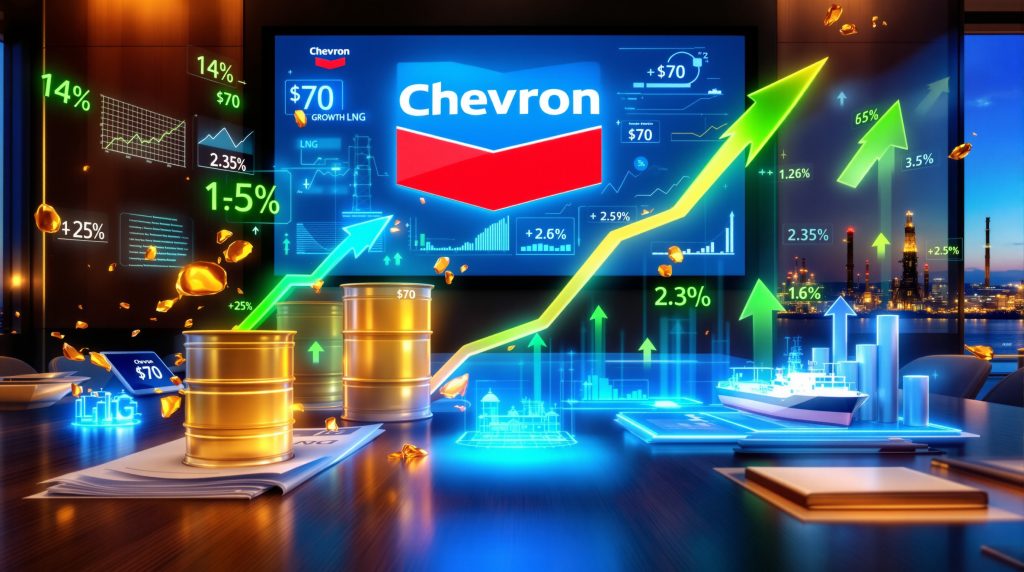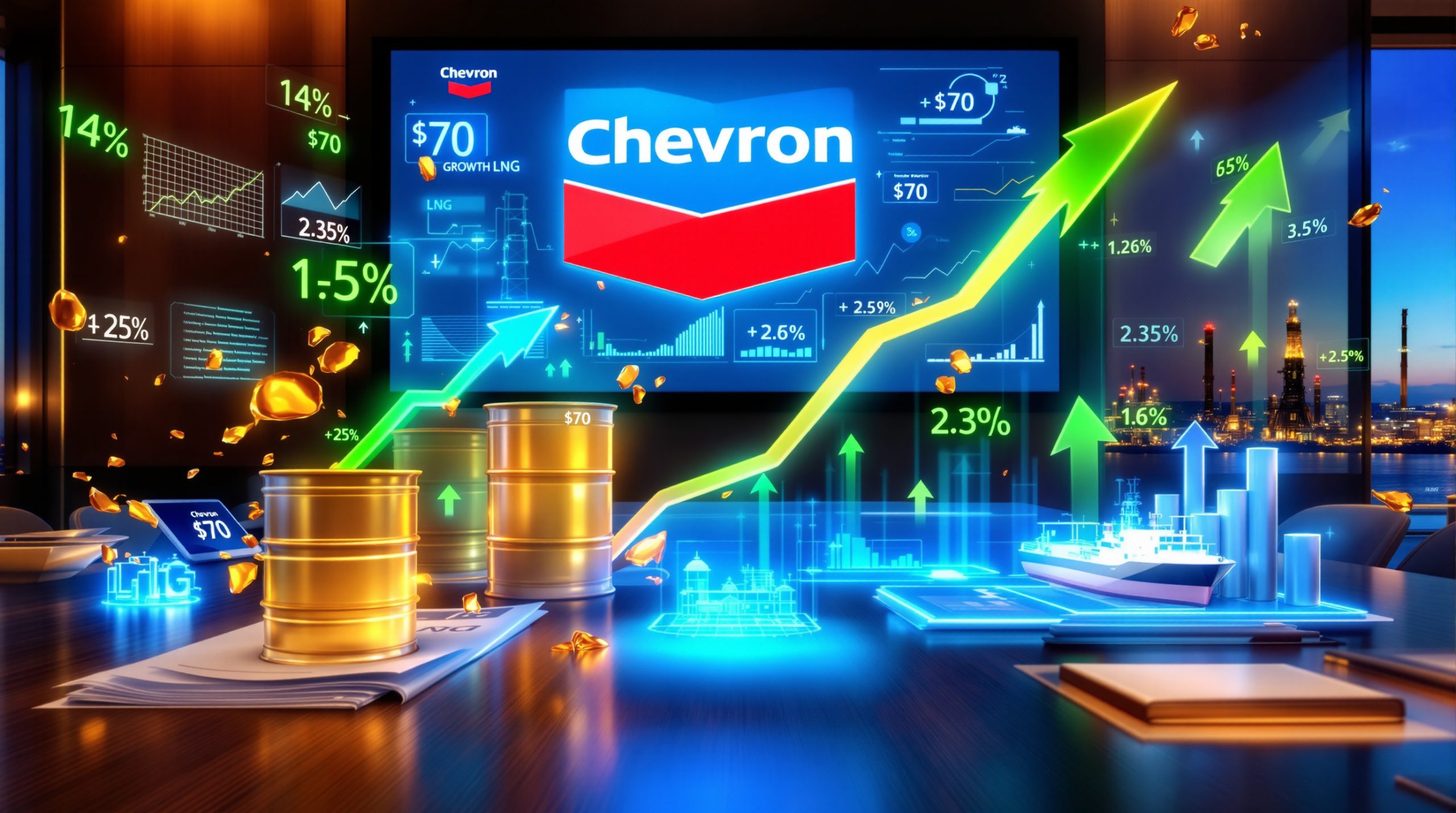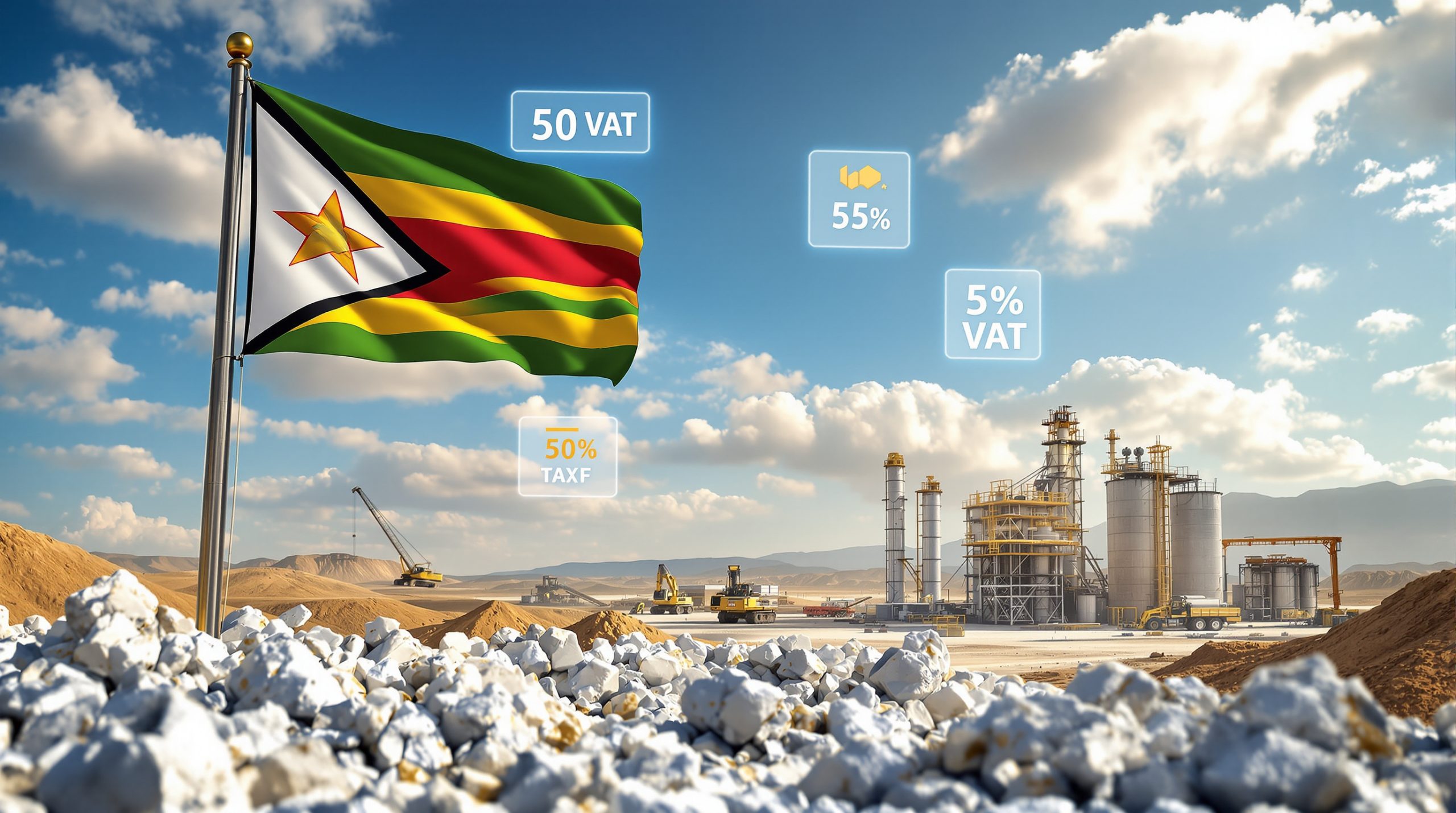Understanding Chevron's 2026 Market Positioning Strategy
Chevron's strategic outlook for 2026 reflects a company positioned to navigate complex market dynamics as both oil and natural gas face significant pricing pressures. The Chevron oil and LNG forecast 2026 indicates a challenging landscape where supply growth outpaces demand, requiring sophisticated operational strategies and financial discipline to maintain profitability.
Corporate Resilience Through Commodity Cycles
Chevron's forward-looking strategy is engineered for resilience across commodity cycles, highlighting portfolio optimisation and a sharp focus on operational efficiency above mere production growth. With the industry navigating volatile pricing, Chevron's five-year framework targets sustained profitability by prioritising projects with strong net present value (NPV) and internal rate of return (IRR)—all anchored around a $70/barrel Brent scenario.
Key structural highlights of Chevron's positioning include:
- Portfolio designed to preserve profitability with Brent crude below $50/barrel
- Capital allocation slanted toward high-return investments rather than sheer expansion
- Diversification across geographies, keeping risk from any single-region event in check
- Rigorous maintenance versus growth capital distinction for project flexibility
These principles were reinforced during Chevron's November 2024 strategic announcement, where CEO Mike Wirth underscored that Chevron prioritises durability and cash returns, boasting a history of reliable shareholder distributions regardless of market downturns.
Free Cash Flow Growth Projections
Chevron projects a robust 14% compound annual growth rate (CAGR) in free cash flow through 2030, assuming a $70/barrel crude environment. This conservative assumption lets Chevron stress-test both upside and downside scenarios, fostering prudent asset selection.
- Free cash flow projections are supported by asset productivity, cost controls, and the integration of new assets
- Structural breakeven thresholds remain below $50/barrel, allowing for operational sustainability even during market disruptions
- Shareholder returns—including steady dividends and share buybacks—are set to remain a cornerstone, supported by surplus cash flow above core capex requirements
Furthermore, Chevron's shift in strategy, moving away from volume at any cost, means the company is less vulnerable to boom-and-bust swings than some competitors that rely solely on production growth. This approach aligns with broader investment strategy components that emphasise risk management and sustainable returns.
Why Will Oil Face Greater Price Pressure Than LNG in 2026?
OPEC+ Production Restoration Impact
The oil market is primed for heightened price pressure throughout 2026, mainly due to a synchronised return of supply from OPEC+ nations that previously curtailed output for market balance. These restoration efforts are structured as gradual, monthly increments expected to fully normalise by late 2026.
- OPEC+ withheld production equates to millions of barrels per day, now returning to market as per scheduled policy adjustments
- Global storage levels, already sufficient, amplify the impact of these incremental additions
- The last major instance of synchronised supply restoration led to price compression, as seen in 2018-2019
The OPEC production impact on global markets cannot be understated, as this coordinated supply return coincides with ongoing growth in North American shale production.
North American Shale Contribution Dynamics
U.S. shale—specifically the Permian Basin—will be pivotal in shaping 2026 price trends. With the Permian now accounting for around 40% of all American oil output—roughly 5.4 million barrels per day—Chevron and its peers are leveraging advanced drilling, completion, and enhanced oil recovery (EOR) techniques to maintain profitable operations at lower benchmarks.
- Technological advances have driven down breakeven costs for top shale operators to $50–$55/barrel
- Drilling productivity (wells per rig, lateral lengths) continues to rise, boosting per-well recovery rates
- The region's rapid output scalability means that supply can ramp up much faster than global demand, feeding into oversupply risks
Moreover, AI-drilling innovations are revolutionising operational efficiency, allowing companies to extract more resources at lower costs. This technological evolution amplifies the supply pressure that will characterise 2026.
Key Insight: 2026 is forecast to represent a temporary low point for crude prices as both OPEC+ and U.S. shale supply intensify together, providing a rare instance of global market oversupply.
How Will Global LNG Supply Expansion Shape 2026 Pricing?
U.S. Export Capacity Transformation
| Year | U.S. LNG Capacity (Million Tons) | Growth Rate |
|---|---|---|
| 2024 | 90 | Baseline |
| 2025 | 110 | 22% increase |
| 2026 | 130 | 18% increase |
The U.S. is cementing its status as a critical global LNG supplier, with capacity projected to jump from 90 million metric tons per annum (MTPA) in 2024 to 130 MTPA in 2026. Major project contributors include Calcasieu Pass, Sabine Pass expansions, and Golden Pass LNG's anticipated start-up.
International Supply Contributors
- Qatar: Ongoing expansion programmes are forecast to add 10–15 MTPA over 2025–2027, underpinning Qatar's role as a global swing supplier
- Australia: Existing facility upgrades and new trains are expected to add several MTPA to the region's baseline
- Middle East: Infrastructure projects in Oman and other Gulf states will support additional incremental supply
Demand-Supply Imbalance Projections
Global LNG demand is expanding at 3–4% annually, propelled by industrial and power generation demand in Asia-Pacific and select European re-gasification projects. However, the balance is shifting significantly.
While long-term contracts secure baseline demand (covering roughly 70–75% of flows), the incremental supply will hit the more volatile spot market. Strong winter demand from northern hemisphere countries supports higher prices in Q1-Q2, but summer shoulder seasons may see pricing softness.
The inflection for a pronounced spot price pullback is anticipated post-2027, based on project completion timelines. This aligns with broader trends in the US natural gas forecast, which indicates similar supply-demand dynamics across North American gas markets.
Industry Table: Structural LNG Market Imbalances
| Factor | Immediate Impact | Longer-Term Impact (2026–2028) |
|---|---|---|
| U.S. LNG growth | High | High |
| Qatar/Middle East expansions | Medium | High |
| Asia import capacity | High | Medium |
| European demand variability | Medium | Low |
What Production Strategy Will Chevron Implement Through 2030?
Measured Growth Approach
Chevron aims for balanced, sustainable growth—seeking a 2–3% annual production increase across both oil and LNG, achieved largely through disciplined capital allocation and high-return projects.
Key strategy elements include:
- Dedicating capex first to highest-margin, lowest-cost assets
- Utilisation of advanced recovery techniques and digital field optimisation to mitigate natural field decline
- Maintaining a globally diversified asset base (U.S., South America, Africa, Asia)
Hess Acquisition Synergies
The 2024 Hess acquisition is central to future production efficiency. Estimated $1.5 billion in operational synergies will be realised through streamlined supply chains, administrative function rationalisation, and optimised joint operations, most notably in Guyana's Stabroek Block and U.S. shale basins.
Integration Benefits at a Glance:
- Administrative cost overlaps eliminated
- Marine and logistics assets pooled for scale
- Harmonisation of drilling and completion techniques
Capital Expenditure Discipline
Chevron's strict investment discipline splits capital between maintenance (~$4–6 billion/year) and growth ($2–3 billion/year), only advancing projects with double-digit IRR and that meet return hurdles even under low commodity scenarios.
Risk Management:
- Commodity scenario planning assesses the impact of low-probability, high-impact market events
- Focus is on core assets; non-core divestitures free up additional cash with minimal value loss
In addition, understanding oil price rally dynamics helps inform strategic decisions about timing capital deployment and operational adjustments.
Which Market Forces Will Drive Energy Price Volatility?
Supply-Side Pressure Points
| Factor | Oil Impact | LNG Impact | Timeline |
|---|---|---|---|
| OPEC+ Restoration | High | Low | 2026 |
| U.S. Shale Growth | High | Medium | 2026–2027 |
| New LNG Facilities | Low | High | 2026–2028 |
Synchronised supply returns (OPEC+ and shale) weigh on oil; LNG faces a slower wave of price pressure from 2027 as new capacity starts up.
Geopolitical Considerations
Energy markets remain vulnerable to:
- Regional stability shocks (Middle East, West Africa)
- Evolving trade relationships and tariffs
- Regulatory frameworks, especially concerning emissions and export restrictions
Economic Recovery Patterns
- Post-cycle industrial demand recovery will dictate the pace and scale of price rebounds
- Transportation's share of oil demand may plateau if global EV adoption accelerates
- Emerging markets remain critical for both oil and LNG long-term consumption growth
Key Insight: Oil prices are highly susceptible to synchronised supply growth, whereas LNG faces more region-specific and timing-delayed volatility.
How Will Chevron Maintain Profitability During Price Pressures?
Operational Excellence Initiatives
Chevron continues cost-reduction programmes targeting both operational and administrative overheads. The integration of digital technologies—AI, predictive maintenance—drives extraction and processing efficiencies whilst minimising unplanned downtime.
- Ongoing focus on margin improvement through technology and process innovation
- Predictive analytics deployed to optimise asset health and boost uptime
Portfolio Optimisation Strategies
- Periodic review and strategic divestment of non-core or sub-economic properties
- Asset prioritisation toward high-margin, low-cost resource plays
- Targeted partnerships to share development risks and accelerate value extraction
Financial Flexibility Mechanisms
- Prudent debt management to secure investment-grade credit ratings
- Commitment to sustainable dividend growth through commodity cycles
- Opportunistic share repurchase tied to surplus free cash generation
Table: Chevron's Response Levers by Market Condition
| Scenario | Core Actions | Supporting Tactics |
|---|---|---|
| Low oil/LNG price | Cost minimisation, high-graded production | Divestitures, capex reallocation |
| High price | Dividend boost, M&A pursuit | Share repurchases, tech investment |
What Long-Term Implications Emerge From 2026 Forecasts?
Market Rebalancing Timeline
Periods of oversupply are expected to persist into late 2027, challenging producers to maintain discipline. For durable price recovery, either above-trend demand growth or the development of new demand centres (e.g., industrial decarbonisation) will be required.
Infrastructure bottlenecks may eventually constrain further supply growth after this period. The Chevron oil and LNG forecast 2026 suggests that companies with superior operational flexibility will emerge stronger from this challenging period.
Investment Strategy Adjustments
- Emphasis on cost-advantaged asset classes
- Accelerated technology deployment to ensure lower lifting costs and improved yields
- Expanding presence in emerging LNG markets to capture outsized growth
Industry Consolidation Opportunities
Mergers, asset swaps, and joint ventures often accelerate during price troughs. Chevron and its peers may use this window for strategic acquisitions—especially distressed assets or operators—for future value creation.
Market Analysis: As multi-source supply surges converge, traditional demand growth may not immediately soak up production increases, leading to extended periods of moderated prices.
Frequently Asked Questions About Chevron's 2026 Outlook
Will Chevron Reduce Production if Prices Decline Significantly?
Chevron's design for operational flexibility allows for production stability through most price cycles. Its breakeven analysis supports continued production even during significant downturns, provided operating cash flow covers maintenance and dividend commitments. Market share retention typically outweighs marginal production adjustments unless prices fall well below $50/barrel for a sustained period.
How Does Chevron's Forecast Compare to Other Major Oil Companies?
Sector consensus identifies 2026 as a price trough for oil driven by synchronised supply growth, but not all operators have diversified assets or such aggressive cost-cutting targets as Chevron. According to Bloomberg analysis, its combination of efficiency, asset quality, and capital discipline positions the company favourably relative to peers.
What External Factors Could Change These Projections?
Primary risks and wildcards include:
- Major geopolitical disruptions affecting large supply sources
- Regulatory escalation (emissions standards, export controls)
- Breakthroughs in extraction or energy conversion technologies reducing future demand
Strategic Implications for Energy Markets Beyond 2026
Structural Changes in Global Energy Trade
- The rise of U.S. and Middle Eastern LNG reshapes global flows, with new trade corridors and revised currency settlement norms
- Emerging market demand changes the locus of trade—Asia and Africa's roles increase, whilst net imports in Europe may plateau or contract
- Infrastructure developments (e.g., LNG terminals, pipelines, shipping) drive long-term market access and price convergence
Technology Adoption Acceleration
- Continued rollout of advanced recovery methods (horizontal drilling, digital twins) boosts resource recovery and cost efficiency
- Carbon capture and storage (CCS) steadily integrates into large-scale developments as emissions controls tighten
- Early-stage integration of renewables with conventional operations supports lower carbon footprints and may unlock additional investment incentives
Consequently, the Chevron oil and LNG forecast 2026 represents more than just price predictions—it reflects a fundamental shift in how energy companies must operate in an increasingly complex global marketplace. Companies that master operational efficiency, maintain financial discipline, and adapt to technological changes will be best positioned for long-term success.
The Chevron oil and LNG forecast 2026 underscores the importance of strategic planning during periods of market volatility. As supply pressures mount across both oil and natural gas markets, energy companies must balance growth ambitions with prudent risk management to navigate the challenging landscape ahead.
Disclaimer: The future projections and scenario analysis presented are speculative and should not be solely relied upon for investment decisions. Market conditions, regulatory frameworks, and technological advancements may evolve differently from those anticipated in this article.
Looking to Diversify Beyond Traditional Energy Markets?
Discovery Alert's proprietary Discovery IQ model delivers real-time alerts on significant ASX mineral discoveries, providing immediate market opportunities that complement traditional energy investments. Historical discoveries have generated exceptional returns, with subscribers gaining critical market advantages through instant notifications of major mineral finds across over 30 commodities. Begin your 30-day free trial today to position yourself ahead of the market and explore why major mineral discoveries can lead to substantial investment returns.




